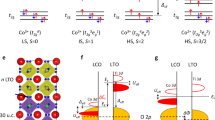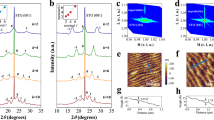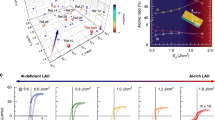Abstract
At interfaces between conventional materials, band bending and alignment are classically controlled by differences in electrochemical potential. Applying this concept to oxides in which interfaces can be polar and cations may adopt a mixed valence has led to the discovery of novel two-dimensional states between simple band insulators such as LaAlO3 and SrTiO3. However, many oxides have a more complex electronic structure, with charge, orbital and/or spin orders arising from strong Coulomb interactions at and between transition metal and oxygen ions. Such electronic correlations offer a rich playground to engineer functional interfaces but their compatibility with the classical band alignment picture remains an open question. Here we show that beyond differences in electron affinities and polar effects, a key parameter determining charge transfer at correlated oxide interfaces is the energy required to alter the covalence of the metal–oxygen bond. Using the perovskite nickelate (RNiO3) family as a template, we probe charge reconstruction at interfaces with gadolinium titanate GdTiO3. X-ray absorption spectroscopy shows that the charge transfer is thwarted by hybridization effects tuned by the rare-earth (R) size. Charge transfer results in an induced ferromagnetic-like state in the nickelate, exemplifying the potential of correlated interfaces to design novel phases. Further, our work clarifies strategies to engineer two-dimensional systems through the control of both doping and covalence.
This is a preview of subscription content, access via your institution
Access options
Subscribe to this journal
Receive 12 print issues and online access
$209.00 per year
only $17.42 per issue
Buy this article
- Purchase on Springer Link
- Instant access to full article PDF
Prices may be subject to local taxes which are calculated during checkout






Similar content being viewed by others
References
Imada, M., Fujimori, A. & Tokura, Y. Metal–insulator transitions. Rev. Mod. Phys. 70, 1039–1263 (1998).
Zaanen, J., Sawatzky, G. A. & Allen, J. W. Band gaps and electronic structure of transition-metal compounds. Phys. Rev. Lett. 55, 418–421 (1985).
Khomskii, D. Unusual valence, negative charge-transfer gaps and self-doping in transition-metal compounds. Lith. J. Phys. 37, 65–72 (1997).
Mizokawa, T. et al. Electronic structure of PrNiO3 studied by photoemission and x-ray-absorption spectroscopy: band gap and orbital ordering. Phys. Rev. B 52, 13865–13873 (1995).
Abbate, M. et al. Electronic structure and metal–insulator transition in LaNiO3−δ . Phys. Rev. B 65, 155101 (2002).
Ushakov, A., Streltsov, S. V. & Khomskii, D. I. Crystal field splitting in correlated systems with negative charge-transfer gap. J. Phys. Condens. Matter 23, 445601 (2011).
Medarde, M. L. Structural, magnetic and electronic properties of RNiO3 perovskites (R = rare earth). J. Phys. Condens. Matter 9, 1679–1707 (1997).
Medarde, M. et al. RNiO3 perovskites (R = Pr, Nd): nickel valence and the metal–insulator transition investigated by x-ray-absorption spectroscopy. Phys. Rev. B 46, 14975–14984 (1992).
Johnston, S., Mukherjee, A., Elfimov, I., Berciu, M. & Sawatzky, G. A. Charge disproportionation without charge transfer in the rare-earth-element nickelates as a possible mechanism for the metal–insulator transition. Phys. Rev. Lett. 112, 106404 (2014).
Mizokawa, T., Khomskii, D. I. & Sawatzky, G. A. Spin and charge ordering in self-doped Mott insulators. Phys. Rev. B 61, 11263 (1999).
Park, H., Millis, A. J. & Marianetti, C. A. Site-selective Mott transition in rare-earth-element nickelates. Phys. Rev. Lett. 109, 156402 (2012).
Weber, C., Yee, C.-H., Haule, K. & Kotliar, G. Scaling of the transition temperature of hole-doped cuprate superconductors with the charge-transfer energy. Europhys. Lett. 100, 37001 (2012).
Chaloupka, J. & Khaliullin, G. Orbital order and possible superconductivity in LaNiO3/LaMO3 superlattices. Phys. Rev. Lett. 100, 016404 (2008).
Boris, A. V. et al. Dimensionality control of electronic phase transitions in nickel-oxide superlattices. Science 332, 937–940 (2011).
Zhang, F. & Rice, T. Effective Hamiltonian for the superconducting Cu oxides. Phys. Rev. B 37, 3759–3761 (1988).
Eskes, H. & Sawatzky, G. A. Tendency towards local spin compensation of holes in the high-Tc copper compounds. Phys. Rev. Lett. 61, 1415–1418 (1988).
Chen, H., Millis, A. J. & Marianetti, C. A. Engineering correlation effects via artificially designed oxide superlattices. Phys. Rev. Lett. 111, 116403 (2013).
Conti, G. et al. Band offsets in complex-oxide thin films and heterostructures of SrTiO3/LaNiO3 and SrTiO3/GdTiO3 by soft and hard X-ray photoelectron spectroscopy. J. Appl. Phys. 113, 143704 (2013).
Disa, A. S. et al. Orbital engineering in symmetry-breaking polar heterostructures. Phys. Rev. Lett. 114, 026801 (2015).
Grisolia, M. N. et al. Structural, magnetic, and electronic properties of GdTiO3 Mott insulator thin films grown by pulsed laser deposition. Appl. Phys. Lett. 105, 172402 (2014).
Bruno, F. Y. et al. Rationalizing strain engineering effects in rare-earth nickelates. Phys. Rev. B 88, 195108 (2013).
Fujimori, A. et al. Doping-induced changes in the electronic structure of LaxSr1−xTiO3: limitation of the one-electron rigid-band model and the Hubbard model. Phys. Rev. B 46, 9841–9844 (1992).
Sakai, E. et al. Gradual localization of Ni 3d states in LaNiO3 ultrathin films induced by dimensional crossover. Phys. Rev. B 87, 075132 (2013).
Middey, S. et al. Polarity compensation in ultra-thin films of complex oxides: the case of a perovskite nickelate. Sci. Rep. 4, 6819 (2014).
Lucovsky, G., Miotti, L., Bastos, K. P., Adamo, C. & Schlom, D. G. Spectroscopic detection of hopping induced mixed valence for Ti and Sc in GdSc1−xTixO3 for x greater than the percolation threshold of 0.16. J. Vac. Sci. Technol. B 29, 01AA02 (2011).
Mochizuki, M. & Imada, M. Orbital physics in the perovskite Ti oxides. New J. Phys. 6, 154 (2004).
Lesne, E. et al. Suppression of the critical thickness threshold for conductivity at the LaAlO3/SrTiO3 interface. Nature Commun. 5, 4291 (2014).
Kleibeuker, J. E. et al. Electronic reconstruction at the isopolar LaTiO3/LaFeO3 interface: an X-ray photoemission and density-functional theory study. Phys. Rev. Lett. 113, 237402 (2014).
Piamonteze, C. et al. Spin-orbit-induced mixed-spin ground state in RNiO3 perovskites probed by x-ray absorption spectroscopy: insight into the metal-to-insulator transition. Phys. Rev. B 71, 020406 (2005).
Liu, J. et al. Quantum confinement of Mott electrons in ultrathin LaNiO3/LaAlO3 superlattices. Phys. Rev. B 83, 161102 (2011).
Freeland, J. W., van Veenendahl, M. & Chakhalian, J. Evolution of electronic structure across the rare-earth RNiO3 series. J. Electr. Spectr. http://dx.doi.org/10.1016/j.elspec.2015.07.006 (2015).
Suntivich, J. et al. Estimating hybridization of transition metal and oxygen states in perovskites from O K-edge x-ray absorption spectroscopy. J. Phys. Chem. C 118, 1856–1863 (2014).
Marianetti, C., Kotliar, G. & Ceder, G. Role of hybridization in NaxCoO2 and the effect of hydration. Phys. Rev. Lett. 92, 196405 (2004).
Liu, J. et al. Heterointerface engineered electronic and magnetic phases of NdNiO3 thin films. Nature Commun. 4, 2714 (2013).
Goodenough, J. B. Theory of the role of covalence in the perovskite-type manganites [La, M(II)]MnO3 . Phys. Rev. 100, 564–573 (1955).
Ohldag, H. et al. Correlation between exchange bias and pinned interfacial spins. Phys. Rev. Lett. 91, 017203 (2003).
Shiratsuchi, Y. et al. Detection and in situ switching of unreversed interfacial antiferromagnetic spins in a perpendicular-exchange-biased system. Phys. Rev. Lett. 109, 077202 (2012).
Ungureanu, M. et al. Using a zero-magnetization ferromagnet as the pinning layer in exchange-bias systems. Phys. Rev. B 82, 174421 (2010).
Nogués, J. et al. Exchange bias in nanostructures. Phys. Rep. 422, 65–117 (2005).
Ali, M. et al. Exchange bias using a spin glass. Nature Mater. 6, 70–75 (2007).
Gibert, M., Zubko, P., Scherwitzl, R., Iñiguez, J. & Triscone, J.-M. Exchange bias in LaNiO3–LaMnO3 superlattices. Nature Mater. 11, 195–198 (2012).
Goodenough, J. B. Covalent exchange vs superexchange in two nickel oxides. J. Solid State Chem. 127, 126–127 (1996).
Ohtomo, A. & Hwang, H. Y. A high-mobility electron gas at the LaAlO3/SrTiO3 heterointerface. Nature 427, 423–426 (2004).
Hwang, H. Y. et al. Emergent phenomena at oxide interfaces. Nature Mater. 11, 103–113 (2012).
Rueff, J.-P. et al. The GALAXIES beamline at the SOLEIL synchrotron: inelastic X-ray scattering and photoelectron spectroscopy in the hard X-ray range. J. Synchrotron Radiat. 22, 175–179 (2015).
Yang, S. H. et al. Making use of x-ray optical effects in photoelectron-, Auger electron-, and x-ray emission spectroscopies: total reflection, standing-wave excitation, and resonant effects. J. Appl. Phys. 113, 073513 (2013).
Chiam, S. Y. et al. Effects of electric field in band alignment measurements using photoelectron spectroscopy. Surf. Interface Anal. 44, 1091–1095 (2012).
Tanaka, H. et al. Nondestructive estimation of depletion layer profile in Nb-doped SrTiO3/(La, Ba)MnO3 heterojunction diode structure by hard x-ray photoemission spectroscopy. Appl. Phys. Lett. 98, 14–17 (2011).
Kresse, G. & Hafner, J. Ab initio molecular dynamics for liquid metals. Phys. Rev. B 47, 558 (1993).
Kresse, G. & Furthmüller, J. Efficiency of ab-initio total energy calculations for metals and semiconductors using a plane-wave basis set. Comput. Mater. Sci. 6, 15–50 (1996).
Perdew, J. et al. Restoring the density-gradient expansion for exchange in solids and surfaces. Phys. Rev. Lett. 100, 136406 (2008).
Liechtenstein, A. I., Anisimov, V. I. & Zaanen, J. Density-functional theory and strong interactions: orbital ordering in Mott–Hubbard insulators. Phys. Rev. B 52, 5467–5471 (1995).
Bristowe, N. C., Varignon, J., Fontaine, D., Bousquet, E. & Ghosez, P. Ferromagnetism induced by entangled charge and orbital orderings in ferroelectric titanate perovskites. Nature Commun. 6, 6677 (2015).
Blöchl, P. E. Projector augmented-wave method. Phys. Rev. B 50, 17953–17979 (1994).
Acknowledgements
The authors thank M. Watanabe for the Digital Micrograph PCA plug-in, F. Y. Bruno for his assistance at an early stage of this project and V. Garcia and R. Mattana for useful comments. The research leading to these results has received funding from the European Community’s Seventh Framework Programme (FP7/2007-2013) under grant agreement #312284. Research at CNRS/Thales was supported by the ERC Consolidator Grant #615759 ‘MINT’ and the region Île-de-France DIM ‘Oxymore’ (project NEIMO). Research at ORNL was supported by the US Department of Energy, Office of Science, Basic Energy Sciences, Materials Sciences and Engineering Division. Work at UCM was supported by grants MAT2014-52405-C02-01 and Consolider Ingenio 2010—CSD2009-00013 (Imagine), by CAM through grant CAM S2013/MIT-2740 and by the ERC Starting Investigator Grant #239739 STEMOX. J.S. thanks the Institute of Physics of CNRS for supporting his stay at CNRS/Thales. We acknowledge synchrotron SOLEIL (proposal no. 20140194) and HZB for provision of synchrotron radiation facilities and the Labex PALM.
Author information
Authors and Affiliations
Contributions
M.B. and M.N.G. designed and conceived the experiment. M.N.G. carried out sample growth and characterization. G.S.-S. and M.V. carried out STEM and EELS analysis. M.N.G., S.V., E.W., E.S., R.A., A.A., A.B., M.B. and J.S. carried out XAS, XRMS and XMCD measurements and data analysis. M.N.G., J.E.R., J.-P.R., J.S. and M.B. carried out photoemission measurements and data analysis. J.V. performed first-principles calculations. M.B., M.N.G. and J.S. wrote the article with inputs from all authors.
Corresponding author
Ethics declarations
Competing interests
The authors declare no competing financial interests.
Supplementary information
Supplementary information
Supplementary information (PDF 1043 kb)
Rights and permissions
About this article
Cite this article
Grisolia, M., Varignon, J., Sanchez-Santolino, G. et al. Hybridization-controlled charge transfer and induced magnetism at correlated oxide interfaces. Nature Phys 12, 484–492 (2016). https://doi.org/10.1038/nphys3627
Received:
Accepted:
Published:
Issue Date:
DOI: https://doi.org/10.1038/nphys3627



